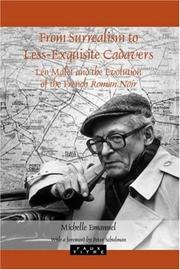| Listing 1 - 1 of 1 |
Sort by
|

ISBN: 9042020806 9789042020801 940120344X 1429481110 9781429481113 9789401203449 Year: 2006 Volume: 288 Publisher: Leiden; Boston : BRILL,
Abstract | Keywords | Export | Availability | Bookmark
 Loading...
Loading...Choose an application
- Reference Manager
- EndNote
- RefWorks (Direct export to RefWorks)
Les nouveaux mystères de Paris (1954-1959), Léo Malet's fifteen-novel detective series inspired by Eugène Sue's nineteenth-century feuilleton , almost achieved the goal of setting a mystery in each of the twenty Parisian arrondissements, with Nestor Burma at the center of the action. In Burma, the "détective de choc" first introduced in 1943's 120 rue de la gare , Malet, considered the "father" of the French roman noir , creates a cultural hybrid, bringing literary references and surrealist techniques to a criminal milieu. Michelle Emanuel's groundbreaking study is particularly insightful in its treatment of Malet as a pioneer within the literary genre of the French roman noir while making sure to also focus on his surrealist roots. Against the archetypes of Simenon's Maigret and Christie's Poirot, Burma is brash and streetwise, peppering his speech with colorful and evocative slang. As the reader's tour guide, Burma highlights Paris's forgotten past while providing insight to the Paris of (his) present, referencing both popular culture and contemporary issues. Malet's innovation of setting a noir narrative in France serves as a catalyst for further change in the policier genre in France, including his contemporary Jean Amila, the néo-polar of Jean-Patrick Manchette, and the historical roman noir of Didier Daeninckx.
Burma, Nestor (Fictitious character). --- Detective and mystery stories, French --- Gothic revival (Literature) --- Surrealism (Literature) --- History and criticism. --- Malet, Léo, --- Malet, Léo. --- Criticism and interpretation. --- Paris (France) --- In literature. --- Malet, Léo --- French literature --- History and criticism --- Malet, Léo, --- In literature --- Detective and mystery stories, French. --- Literature, Experimental --- Avant-garde literature --- Experimental literature --- Avant-garde (Aesthetics) --- Modernism (Literature) --- Literary style --- French detective stories --- French mystery stories --- French fiction --- Malet, Léon Jean, --- Harding, Frank, --- Refreger, Omer, --- Doucet, Lionel, --- Latimer, Leo, --- Burma, Nestor (Fictitious character) --- Surrealism in literature --- Literature --- Literary movements --- Revival movements (Art) --- Romanticism --- Nestor Burma (Fictitious character) --- Detective and mystery stories, French - History and criticism --- French literature - 20th century - History and criticism. --- Malet, Léo, - 1909 --- -Paris (France) - In literature --- -Paris (France)
| Listing 1 - 1 of 1 |
Sort by
|

 Search
Search Feedback
Feedback About
About Help
Help News
News